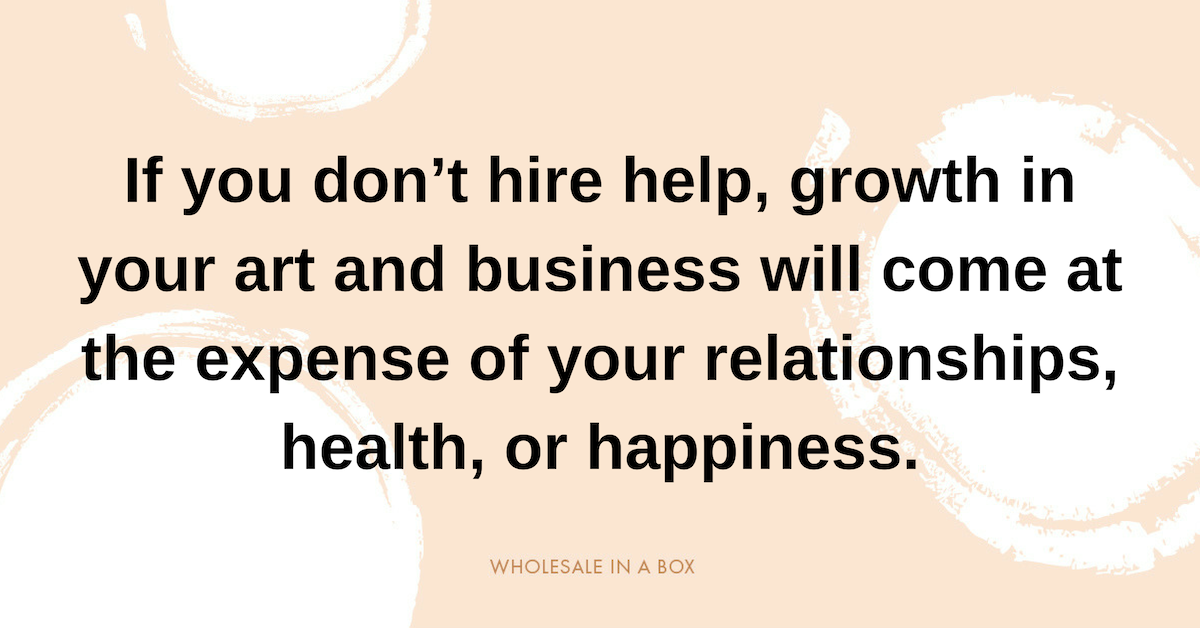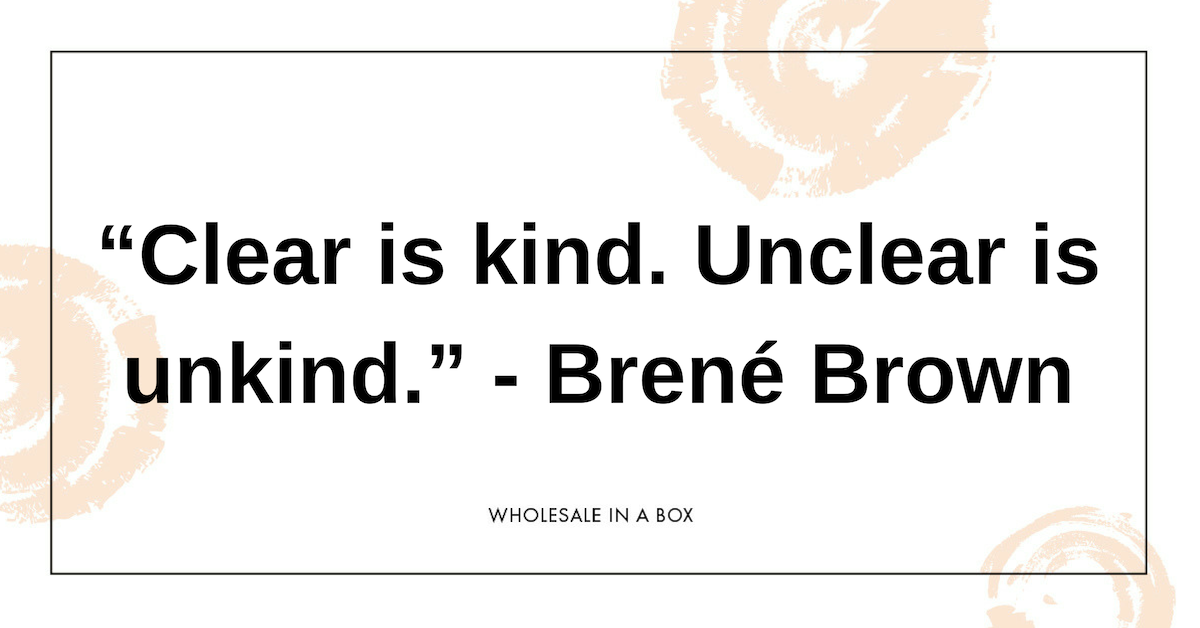Don’t Hire Someone to Be Your Best Friend (And 6 Other Hiring Tips)
First of all, I hear you. HIRING IS HARD. It’s hard to manage people. It costs money. It takes a huge amount of time to find, vet and train people. You don’t have a big enough studio. You’re an introvert. You have just a small amount of work available. You live in a tiny town. You’re an artist, not a manager. You tried that last year and it didn’t work out.
But no matter how hard you work, or how Beyonce-like you may be, there are still only 24 hours in a day. So in order to build something more evolved than what you are currently doing, you need to involve other people.
If you don’t hire help, growth in your art and business will come at the expense of your relationships, health, or happiness. As Debra of @aerlumejewelry recently shared of her hiring experience:
Hiring a production assistant for my jewelry business is one of the single BEST decisions I made. I agonized over the decisions for months! It was scary taking on that big responsibility for another’s livelihood but hiring help is the ONLY reason I’ve able to grow and expand my business.
And I honestly believe that most makers should be hiring help -- but that it likely won’t take the traditional form of a full-time (or even part-time) studio assistant. If you’ve ever felt overwhelmed with all you have to juggle as a maker, business owner, artist, and human being, read on.
7 things I’ve learned about hiring help (even as a tiny handmade business):
1. Make a list of your Jobs To Be Done
The biggest mistake people tend to make when hiring is that they think in terms of job titles, for instance: “I need to hire a studio assistant.” The problem with this is that the job titles you’ve heard of may not meet your needs in terms of your budget or what you actually need done in your business. So I recommend thinking in terms of Jobs To Be Done (JTBD), instead.
How to begin? Make a list of all of the things that need to get done to maintain or grow your business and that YOU don’t HAVE to be the one to do. Prioritize them -- the highest priority tasks to outsource are those that will move the needle on your income and are those that you are least good at or enjoy doing least. Once you have your set of high priority projects, begin to envision the traits of the future project do-er. This starts to become your job posting. We spoke with Katie, of Katie Dean Jewelry, at the beginning of this year for our Mentor Intensive. Here’s what she said about when she knew it was time to hire:
I had gotten to the point where I was so exhausted that I would have conversations with people and then wouldn’t be able to remember what had been said. Ultimately, I knew I had to make a shift for my well-being and that it wasn’t selling out. It was very gradual, though. I think the best way to do hiring is to do everything yourself until there simply isn’t enough time in the day to do what you need to do, or the volume of product is more than you can produce. At that point, you hire someone on.
2. Find the money.
I always laugh when people recommend finding the money for hiring by “cutting out that latte habit” and using that money to bring on help for your business. Most small business owners wish they had enough money to have a latte habit in the first place. So I won’t tell you to find your hiring money by trimming luxuries you never had.
But -- many of us are wasting money or leaving money on the table by under-hiring because we have a scarcity-based impulse. So I will tell you to take a hard look at your finances and identify any money you can spare. You need less money than you assume to hire. And you probably have more money available to you than you think. In a recent interview, Aftyn from Rise and Wander says that although she and her husband have a tight budget, they sit down at the end of every year, look at all of their spending, and figure out what they could downsize, change, or cut out to make room to hire more help.
3. Hire for the right number of hours.
Many people assume that you can only hire people for 20-40 hours per week. But the truth is that you can hire people for a day per year in the busy season… or a weekend per month… or 5 hours per week… or any other structure in between. It can be consistent or it can be seasonal. So consider your list of Jobs To Be Done and consider the amount of money you can possibly round up to spend on the new hire. The number of hours you hire for should come from your JTBD and budget -- not the other way around. Jennie of Jenny Lemons shop and brand explained a bit of her thought process when it comes to hiring during our Mentor Intensive:
I have an assistant who helps me 1-2 days per week, who helps me and who is also a small business owner who is getting started. I’m also looking into hiring an actual employee. And I’m really committed to working with artists and small biz owners.
In terms of how much to pay, it depends on the job and also on minimum wage. I wish I could pay what Google pays people. But minimum wage in San Francisco is $14, which is really high, so I start people at $15 because I don’t want to be minimum wage but it’s also what I can afford and what I think is fair.
4. Don’t hire someone to be your best friend.
The personal relationships I have with my team are some of the most satisfying, positive relationships I have. It’s such a beautiful thing when we connect deeply and personally with the people we work with. That said, I didn’t hire my team to be my friends -- I hired them to fill functional roles on the team. I recently heard Whitney Johnson put it like this:
When we’re hiring people, we’ve got functional roles we need to fill on our team. But one of the pitfalls for people is we’re not clear on the emotional jobs we’re hiring for. And I think we have to be really, really reflective because it sometimes shows the underbelly of who we are. Sometimes we hire someone because we want them to take care of us… or hiring someone because we want someone to talk to… or to have them somehow take care of the business.
Hire people who are good for your business and hire them to do jobs that need to be done. Don’t hire as a salve your own emotions, to bring a “cool factor” to your business, or to give you a pass as a business owner.
5. Find the people.
When we first started hiring, I only shared my job posting through our social media, email list, and personal networks. And it always seemed like an uphill battle to find enough great candidates fast enough. Since then, I’ve found that paying to post jobs can be very much worth the money, even though it’s a tough pill to swallow. When you’re making your budget, plan on spending some money on finding and training your new hire -- rather than assuming those costs will be zero. Depending on the type of work you’re hiring for, consider Handshake, Upwork, FreeeUp, Working Nomads, local universities, local job boards, or other for-pay places. It doesn’t matter as much which board you choose -- the important thing is to treat it like a real hiring process, not just a matter of hiring someone you know.
6. Start with a trial project.
This is a bit of detail, but it’s a detail that I’ve found powerful. It’s hard to get to know someone in the course of the hiring process. And every job has its own quirks. So I recommend starting every new hire with a small trial project so you can see in action whether there is a fit between the person you hired and the job they’ll be doing. Pick something representative of what the job entails, but that doesn’t require a ton of training -- and make sure they can complete it in less than a week. At the end of the trial project, step back and assess whether they did a fantastic job on the work itself, as well as demonstrated the values and character traits that you want to see in the hire.
7. Be clear.
The biggest mistake I see inexperienced leaders, hirers, and managers make is that they are unclear. They’re unclear about the good, bad, and ugly of their job when they’re hiring. They’re unclear in the training process. And they’re unclear with criticism and praise. My teammate Simone says, “overcommunication is good communication.” So overcommunicate in your job posting about what the job is really like. Overcommunicate in your training and management. Overcommunicate about feedback and concerns… as well as about praise and gratitude and what’s going right. And as Brené Brown says, “Clear is kind. Unclear is unkind.”
A hiring case study…
I spoke with Jonnie from Grey Theory Mill about her recent hiring experiences and she had some wonderful wisdom to share. She is based in San Diego and is a beautiful force in the maker community. Her line is a spirited blend of cheek and class, and Jonnie had some great thoughts on the mountain tops and valleys of hiring:
Finding “Goldilocks”
Cliché, but it really is about finding the right person. I had hired 3 people before landing my "dream girl", and they were good, but--to quote Goldilocks--they weren't 'just right'. I had known most of last year I needed to hire help, but it really set in during my August tradeshow when I noticed a fellow maker had a friend she flew in to help her with the show. My thought was, "who would I fly in to help me sell my brand here?" I don't have an extensive list of friends who aren't already makers, and many of my friends are neck deep in raising kids, OR pursuing careers, OR wouldn't be a good fit, but one friend did come to mind.
Navigating business and friendship
When I got back into town I asked this friend if she would ever be interested in helping me with shows. Her whole face lit up and she enthusiastically agreed. Later she approached me and shyly told me she's always been interested in learning about jewelry, loves to make things, and asked me if I would consider teaching her how to make the jewelry--as an intern. I was so excited that I immediately said yes. I hadn't asked her if she wanted to do anything else because she has a career, I just didn't know at the time she was wanting a change.
Jonnie and Monica of Grey Theory Mill
I had been saying I didn't want to hire a friend, but I guess there was a loophole if that friend was, "just right." It also helped that this friend is one of the most considerate humans I know and literally said, "if I am not good at this or not a good fit, your success is important to me and I want our friendship to be unaffected by this." Without knowing it, I had hit the jackpot.
Diving in as a team
I hired her in September and we started with small things and had fun. By the time we hit December, she knew how to make all the dangly earrings and a good deal of the necklaces. The icing on the cake was, I didn't have to train her at all on shows. She's inherently amazing at representing and selling.
Training is tedious work (and something that made me dread hiring someone because it would slow production down), but I knew looking at the long road ahead, there would be four capable hands instead of two very tired and distracted ones.
Breathing and evolving
Hiring her gave me the breathing room my subconscious knew I needed, but my pride was hiding. I'm beyond grateful and so excited to have her on my team.
Now we're in the second quarter and I have trained her to do email marketing. She caught on quickly and I now consider her better at it than myself!
Jonnie’s tips on hiring:
Say exactly what you want out loud OR write it out. I firmly believe in the answers/things/people you need showing up when you get the thought out of your head and into the world.
Hiring friends can be amazing or a total shit show. You should be able to tell or know if a working relationship added to a friendship might cause damage.
Start delegating and training them on the tasks you hate. Telling them you hate said tasks is optional. I told mine after she said she LOVED doing X + Y! My response was, "AWESOME! That's my least favorite!!"
Set goals and reasonable expectations based on their experience. For a lot of my jewelry, I can make a piece in X amount of minutes. I share that with her so she knows that that is where she should be reaching.
Tell them when they make you proud!!! Tell them when the mess up, but don't get mad! You've been doing this for YEARS. They are learning a whole new trade.
Spoil them. Seriously, if they are your "IT" person, your "just right" person, spoil them. Even if it's small spoils like their favorite coffee, small gift card, lunch, etc. Be a boss they want to work with and for. Be a cool job; my employee basically gets any free jewelry she wants, she gets treated to the restaurant of her choice after shows, I went BIG on her Christmas presents, I round up on hours, etc.”
Hiring is an intimidating process. Building a job description takes time, training is tiring, and there are other challenges to overcome. But here’s the reality of it: creating a team of people who are excited about your business and mission will not only energize you, it will empower you to bigger, more beautiful aspects of your art and business.
So, embrace honesty and ask yourself what you need. Look truthfully at your finances in order to leverage your business’s fullest potential. Start small and incorporate sample projects as a part of your hiring process. Above all, clearly articulate what and who you need to launch your business into a better place.
As Jonnie reminded us, it may take a few tries to find your “Goldilocks” team. But be patient with yourself and embrace flexibility in this new adventure. When you find those great teammates, your art, business, and relationships will be all the better for it.




